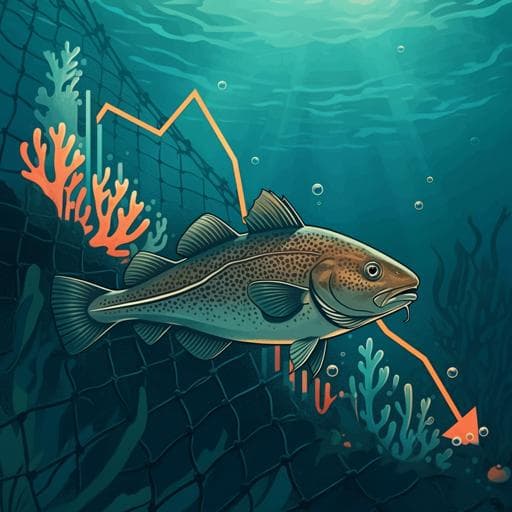
Environmental Studies and Forestry
Addressing the dichotomy of fishing and climate in fishery management with the FishClim model
G. Beaugrand, A. Balembois, et al.
The FishClim model offers groundbreaking insights into the dual influences of fishing and climate-induced environmental change on North Sea cod populations from 1963 to 2019. Highlighting nearly equal contributions to stock fluctuations, this research by Grégory Beaugrand, Alexis Balembois, Loïck Kléparski, and Richard R. Kirby underscores the critical need for adaptive management strategies to avert potential stock collapse.
~3 min • Beginner • English
Introduction
Managing fish stocks is difficult because stocks exist in complex ecosystems subject to extrinsic (fishing and climate-induced environmental change, CIEC) and intrinsic (biological/ecological) forces. Stock collapses can arise from overexploitation or climate-driven range and productivity changes. For North Sea Atlantic cod (Gadus morhua), long-term declines since the gadoid outburst have prompted debate over the relative roles of fishing and CIEC. While joint effects have been studied, precise quantification of each driver’s contribution over time has been lacking, limiting effective management and often ignoring environmental influences. This study develops and applies the FishClim model to quantify how fishing intensity and CIEC jointly and dynamically influence cod Spawning Stock Biomass (SSB) from 1963–2019 and to project future effects (2020–2100) under CMIP6 scenarios, aiming to resolve the fishing–climate dichotomy for better management.
Literature Review
Prior work has shown interactions between climate variability/change and fishing on cod and other marine species, including spatial redistributions attributable to warming vs fishing pressure (e.g., Engelhard et al. 2014 for North Sea cod) and multi-decadal analyses of cod in the Baltic Sea that partitioned influences of eutrophication, predation, climate, and fishing (e.g., Eero et al. 2011). Earlier North Sea studies linked plankton-driven recruitment variability to cod survival and gadoid outburst dynamics, and highlighted synergistic impacts of climate and fishing on ecosystems. Despite this, fisheries management has often not integrated CIEC into reference points, and quantitative, time-varying attribution of fishing vs climate on SSB has been rare. The paper builds on species distribution/niche modeling literature (e.g., METAL, NPPEN, MaxEnt) and management concepts like MSY/BMSY and dynamic reference points, noting ongoing debates and challenges around MSY and multispecies contexts.
Methodology
- Study system and period: North Sea cod, analyses from 1963–2019 with projections to 2100 (and to 2300 for one ESM scenario). Spatial grid 0.25°×0.25° for seas around the UK.
- FishClim population model: Standardised SSB (dSSB) X_{t+1} = X_t + r X_t (1 − X_t/K_t) − α X_t, where r is population growth rate (primarily set to 0.5; sensitivity also at 0.25 and 0.75), α is fishing intensity (0–1), and K_t is maximum standardized SSB (mdSSB) determined solely by environment (CIEC) in absence of fishing.
- mdSSB (K_t) assessment via niche model (METAL framework): multiplicative niche combining three dimensions:
• Thermal niche: asymmetric Gaussian with optimum 5.4°C, standard deviations τ1=5.7°C (below optimum) and τ2=4°C (above), scaled 0–1.
• Bathymetric niche: trapezoidal suitability with θ1=0 m, θ2=0.01 m, θ3=200 m, θ4=600 m, scaled 0–1.
• Trophic niche: binary daily suitability set to 1 when chlorophyll-a > 0.05 mg m−3 for at least 15 consecutive days, else 0. K is the product of the three components.
- Data inputs:
• SST (1850–2019): COBE SST2 (1°), interpolated to 0.25° monthly.
• Bathymetry: GEBCO_2019, interpolated to 0.25°.
• Chlorophyll-a: Observed satellite merged product (1997–2019) for spatial patterns; modelled chlorophyll from CMIP6 ESMs for long-term changes.
• Biological time series (1963–2019): ICES cod recruitment at age 1, SSB, fishing effort F. Plankton index of larval cod survival (CPR-based PCA of six indicators for March–September, 1958–2017).
• Climate projections: CMIP6 daily SST and chlorophyll from four ESMs (CNRM-ESM2-1, GFDL-ESM4, IPSL-CM6A-LR, UKESM1-0-LL) under SSP245 and SSP585 (2015–2100; with historical 1850–2014).
- Temporal aggregation: Annual averages for mdSSB computed over March–October (productive season). North Sea region defined as 51°N–62°N and 3°W–9.5°E.
- Estimation of fishing intensity α (1963–2019): ICES SSB series standardized to dSSB; α derived by embedding ICES dSSB in the population equation to maximize correlation with ICES F. Verified correlation between α and F (r=0.56, PACF=0.04, n=56).
- Reconstruction and attribution analyses:
• Generated four hypothetical scenarios to isolate influences: (i–ii) constant min/max α with varying K_t (CIEC), (iii–iv) constant min/max K with varying α; compared to reconstructed ICES dSSB.
• Computed time-varying influence indices for fishing and environment via residual comparisons and performed hierarchical clustering (Euclidean, average linkage) on years × (ICES SSB, fishing influence, environmental influence) to define periods P1–P7.
• Calculated an index of fishing influence ε (%) using two indicators (γ: dSSB with fluctuating α and best K; δ: dSSB with fluctuating environment and α vs minimal α baseline). Applied Jackknife resampling within each period to obtain ranges.
- Projections and management scenarios:
• Computed mdSSB trajectories (1850–2100) from ESMs; also dSSB under a constant standardized catch (α≈0.03, mean 2008–2019) for SSP245/585.
• Constructed response surfaces of dSSB across grids of K (0–1) and α (0–0.5) to visualize sensitivity and overlay historical and projected points.
• Recovery simulations: From collapse (dSSB=0.1 of K) to target dSSB=0.4 under moratorium (α=0) for r=0.25, 0.5, 0.75 across K values.
• Extirpation mapping (2020–2100): Year when X_t falls to 0.1 under (a) constant α=0.04 and (b) adjusted fishing using MSY-based a_MSY to maintain X≥K/2; compared SSP245 vs SSP585 differences and constant vs adjusted fishing via histograms of year differences (medians reported).
• Pooled standardized catch (2020–2100): Compared scenarios of constant vs adjusted fishing and SSP245 vs SSP585; computed percentage reductions and medians over the North Sea.
Key Findings
- Model validation and environmental drivers:
• Spatial mdSSB (1997–2019) matched known cod distribution in the NE Atlantic.
• In the North Sea, long-term mdSSB correlated strongly with recruitment at age 1 with 1-year lag (r=0.79, PACF=0.02, n=56) and with a plankton index (r=0.73, PACF=0.04, n=60). Correlation with ICES SSB was not significant due to fishing influence (r=0.52, PACF=0.23).
- Fishing intensity estimation:
• Estimated α correlated with ICES fishing effort F (r=0.56, PACF=0.04, n=56) and enabled reconstruction of ICES dSSB.
- Interaction of fishing and CIEC (1963–2019):
• Scenarios showed lowest dSSB under either high α or environmentally unsuitable K, and highest dSSB under low α and favourable K.
• During the gadoid outburst (1963–1983), favourable environment with moderate fishing supported high SSB; increased fishing during the second phase reduced SSB despite positive environmental influence.
• From late 1980s to 2007, strong adverse environmental shift plus considerable fishing led to collapse (2000–2007).
• Post-2008, reduced fishing allowed SSB increases despite continued environmental unsuitability.
- Quantified attribution:
• Overall (1963–2019), fishing and CIEC contributions to SSB changes were approximately 55% (range 55–56%) and 45% (44–46%), respectively.
• Period-specific fishing influence (Jackknife, approximate averages): P2 (gadoid outburst early): near-equal; P3–P4 (second phase/outburst to late 1980s): fishing dominant (~69–78%); P5 (1990s): fishing ~59–61%; P6 (2000–2007 collapse): ~50–51% each; P7 (2008–2019): fishing reduced to ~34–36%, environment ~64–66%.
- Future projections:
• mdSSB predicted to decline substantially under both SSP245 and SSP585, with stronger reductions under SSP585; average mdSSB difference between scenarios by late 21st century ~0.09 (range 0.08–0.13), a 36.1% reduction (range 30.8–43.8%).
• Adding constant standardized catch (α≈0.03) under SSP245 reduced dSSB by ~39% (33.3–44.5%) relative to mdSSB; under SSP585 plus constant catch, models projected pronounced reduction from 2082–2087 and full extirpation (dSSB=0) from 2088 onwards in one scenario.
• Response-surface analysis showed that as environment (K) becomes less suitable, the scope to stabilize or rebuild SSB by reducing fishing diminishes markedly.
- Recovery potential:
• From dSSB=0.1 to target 0.4 with α=0: at K=1, recovery times 3.9, 5.1, and 8.6 years for r=0.75, 0.5, 0.25, respectively; when K approaches the target (e.g., K=0.401), recovery slows to 8.0, 12.9, and 27.2 years.
- Management and climate scenario impacts (2020–2100):
• Adjusting fishing (MSY-based) delays extirpation vs constant fishing, especially under strong warming: North Sea median delays of 3 years (SSP245) and 25 years (SSP585) for adjusted vs constant fishing; warming-induced differences in extirpation timing smaller when fishing is adjusted (median delay 4 years) vs constant (16 years).
• Combined uncontrolled warming and constant fishing hasten extirpation; median 28-year difference between SSP585 constant fishing and SSP245 adjusted fishing.
• Pooled standardized catch (2020–2100): Not adjusting fishing reduces pooled catch by 9.9% (SSP245) and 27.1% (SSP585) relative to adjusted; warming from SSP245 to SSP585 reduces pooled catch by 27.7% (constant fishing) and 12.7% (adjusted). Combined poor management and intense warming yield median 35.8% reduction.
Discussion
The FishClim framework reveals that fishing and climate-induced environmental change act jointly and variably over time to shape cod SSB, with periods of synergy (e.g., late 1980s–2007 collapse) and antagonism (e.g., phases of the gadoid outburst and post-2008). Model–data comparisons support the strong environmental control on recruitment via plankton-mediated larval survival, while fishing directly reduces SSB and can amplify climate sensitivity through life-history and demographic pathways. The quantified attribution (overall ~55% fishing, ~45% CIEC since 1963) reconciles the debate by showing both drivers are material and time-varying. Looking forward, projected environmental degradation under anthropogenic warming lowers mdSSB and progressively limits the effectiveness of management levers; under strong warming, some scenarios lead to local extirpation despite reduced catches. Nonetheless, dynamic adjustment of fishing effort (e.g., MSY-based accounting for changing K) can delay extirpation and sustain higher cumulative catches compared to constant fishing. Recovery analyses highlight that preventing collapse is far easier than rebuilding under degraded environmental regimes, underscoring the need for dynamic reference points that track environmental productivity. Overall, effective fisheries management must integrate real-time environmental monitoring and adapt fishing mortality to CIEC, while broader climate mitigation enhances the feasible management space.
Conclusion
The study introduces FishClim, a spatiotemporal model that disentangles and quantifies the respective and joint influences of fishing and CIEC on cod SSB. Applied to North Sea cod, both drivers contributed nearly equally (55% fishing, 45% CIEC) over 1963–2019, with substantial temporal variability and episodes of synergy causing collapse. Projections indicate substantial future declines in mdSSB, with potential extirpation under high-emission scenarios if fishing is not adaptively controlled. Immediate management implications are to abandon the dichotomy between fishing and climate by integrating CIEC into dynamic reference points and adjusting fishing effort promptly to environmental shifts to avoid response lags and collapse. Future directions include extending FishClim to other stocks and species, incorporating size/age structure, dynamic population growth rates, migration, multispecies interactions (MMSY), and refining environmental drivers, while using ensembles of ESMs to manage projection uncertainty.
Limitations
- The model estimates standardized SSB and does not include explicit age/size structure, which can be important for management.
- Natural mortality is not explicitly modeled; it is assumed to be implicitly captured within the growth term via environmental effects on K.
- Population growth rate r is held constant in most analyses, though it may vary with temperature and food; dynamic r was not implemented due to uncertainty.
- Migration is not modeled; assumptions are that migration has limited impact at the North Sea scale, though movement ecology is complex and spatial structure exists.
- Standardization of ICES SSB and estimation of α involve choices that introduce uncertainty; the correlation with ICES F is moderate.
- Inter-ESM variability is substantial and emission scenarios are uncertain, affecting projections.
- Environmental niche simplified to SST, bathymetry, and chlorophyll-based proxy; other ecological dimensions (e.g., oxygen, multispecies interactions, eutrophication) are not included for the North Sea case.
- MSY-based adjustments use BMSY-like concepts; multispecies dynamics (MMSY) could affect α estimates and outcomes.
Related Publications
Explore these studies to deepen your understanding of the subject.







